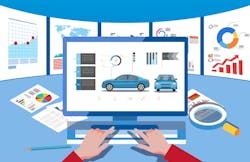It’s no secret that technology has completely transformed the mechanical repair industry—and the automotive industry at large, as well. From tools and equipment to software, a dramatic shift in technology has both revamped how auto repair shops work and how they maintain relationships with customers and vendors alike.
One of those relationships is with jobbers, and according to Epicor’s Scott Thompson, it’s a relationship that’s been impacted quite a bit, thanks to technology.
Thompson has spent most of his career in the aftermarket and joined Internet AutoParts as president and CEO in 2007. Now part of the Epicor product family, Thompson now serves as vice president of automotive, content and analytics. He recently sat down with Ratchet+Wrench to explain trends in the relationship evolution between shops and jobbers.
How has the jobber and the service center relationship evolved over the years or what do you see really the service centers needing from their jobbers today?
A couple of trends that we’re observing in the changing market is the number of business relationships is growing and its natural extension of the exploding number of parts that exist in the market.
From a practical perspective, unless you happen to be in a career with very narrow geography, no single supplier can supply all the parts that you need and your business needs. The number of those business relationships are growing and what its really doing is expanding a need that this kind of technology can really find those parts, make sure you know how much they are, get them on their way to you, sooner than having to make four different phone calls, trying to find a part, understanding the price, then going back to the customer to tell them what the jobs going to be.
All of the technology is really helping bring the technician and the service advisor a lot of business. Any minutes or hours you can take out of the time for when they receive the vehicle to when they can begin to repair it, gives them more time and better pace, and that’s what helps them be more successful.
The power of having all of that stuff integrated now in a way that can be consumed and exchanged with their customer is tremendous. When you’re a successful service provider, it’s always about getting cars in and out of your bays and it still is. It’s just that the complexity of doing that efficiently is growing our market with the complexity of vehicles, the number of parts, the number of repairs, the challenge of finding the technicians that understand all of those things.
On the jobber side, what are some of the trends affecting their business?
The realization that business software is a driver of sales, profits and loyal customers. You can no longer rely on outdated business solutions. Those who make these investments will be the survivors in an increasingly competitive market. Those who don’t will likely find themselves working longer and harder simply to maintain the business they now have.
How does "big data" and some of those larger trends in analytics apply to the jobber side?
The next step in this evolution will be the application of predictive analytics to the consumers’ service experience. Our customers can tell consumers, for example, that most owners of a given vehicle also have rotors replaced when doing brake jobs. Or, we can show them the incidence of a given part failure, such as a hub bearing. The bottom line in all of this is the value provided to the end customer, who doesn’t necessarily relish the opportunity to leave their vehicle at the repair shop.
Every major program group is now leveraging its own data warehouse to make better buying, pricing and merchandising decisions. Big data is now driving decisions at the supplier level and among aftermarket channel partners. Many of our customers are leveraging this insight to strengthen their relationships with shop accounts. Shop owners can absolutely benefit from knowing which types of services are being performed most often in a given area, as well as parts consumption trends by application both on a local basis and nationally.
